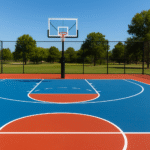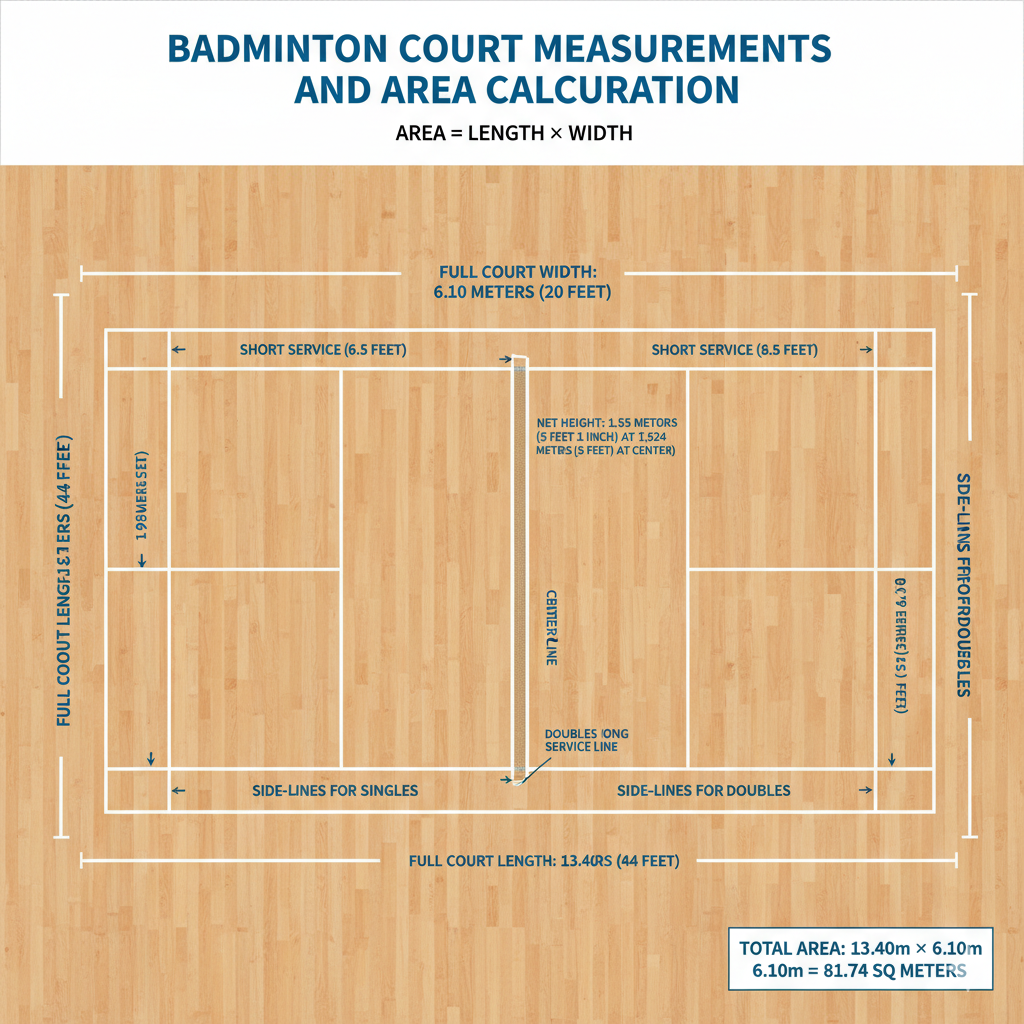Introduction
Badminton is one of the most popular indoor sports in the world. Its popularity lies in its simplicity, accessibility, and fast-paced gameplay. But behind every professional match lies a carefully measured playing surface that follows strict international standards. The Badminton World Federation (BWF) defines the official dimensions and layout of a court to ensure uniformity across all levels of play.
One of the most frequently asked questions is: “What is the area of a badminton court?” While the answer may sound simple, the calculation involves understanding the court’s dimensions, the differences between singles and doubles play, and additional buffer zones required for safe play.
This article breaks down the exact measurements, rules, and calculations of a badminton court area.
Official Badminton Court Dimensions
According to BWF regulations, a badminton court is a rectangular area measuring:
-
Length: 13.40 meters (44 feet)
-
Width: 6.10 meters (20 feet)
-
Total Playing Area: 81.74 square meters (880 square feet approx.)
These dimensions remain constant for both singles and doubles matches. The difference lies only in the markings that define the boundaries for singles and doubles play.
Calculating the Court Area
To calculate the area of a standard badminton court, we apply the simple formula for the area of a rectangle:
Area=Length×Width\text{Area} = \text{Length} \times \text{Width}Area=Length×Width
-
Length = 13.40 m
-
Width = 6.10 m
Area=13.40×6.10=81.74 m2\text{Area} = 13.40 \times 6.10 = 81.74 \, \text{m}^2Area=13.40×6.10=81.74m2
Thus, the official area of a badminton court is 81.74 square meters.
For those using imperial units:
44 ft×20 ft=880 sq ft44 \, \text{ft} \times 20 \, \text{ft} = 880 \, \text{sq ft}44ft×20ft=880sq ft
Singles vs. Doubles Area
The overall court dimensions do not change, but the playable width differs:
-
Singles Court Width: 5.18 meters (17 feet)
-
Singles Court Area:
13.40×5.18=69.41 m2 (approx.747 sq ft)13.40 \times 5.18 = 69.41 \, \text{m}^2 \, (approx. 747 \, \text{sq ft})13.40×5.18=69.41m2(approx.747sq ft)
-
Doubles Court Width: 6.10 meters (20 feet)
-
Doubles Court Area:
13.40×6.10=81.74 m2 (880 sq ft)13.40 \times 6.10 = 81.74 \, \text{m}^2 \, (880 \, \text{sq ft})13.40×6.10=81.74m2(880sq ft)
So, while the total court size remains the same, singles matches occupy less area due to narrower sidelines.
Service Court Dimensions & Area
Each side of the net is further divided into service courts:
-
Service Court Length: 4.72 meters
-
Service Court Width: 2.59 meters
-
Service Court Area:
4.72×2.59=12.23 m24.72 \times 2.59 = 12.23 \, \text{m}^24.72×2.59=12.23m2
Since there are four service courts on the entire playing surface (two on each side), the combined area of service courts equals:
12.23×4=48.92 m212.23 \times 4 = 48.92 \, \text{m}^212.23×4=48.92m2
This makes up a significant portion of the court and is crucial for serving regulations.
Net Dimensions
The net divides the total area into two equal halves:
-
Half-Court Area (per side):
13.40÷2=6.70 m (half length)13.40 \div 2 = 6.70 \, \text{m (half length)}13.40÷2=6.70m (half length) 6.70×6.10=40.87 m26.70 \times 6.10 = 40.87 \, \text{m}^26.70×6.10=40.87m2
Thus, each side of the court (separated by the net) has 40.87 square meters of playable area.
Buffer Zones & Total Playing Space
In actual practice, the court area alone is not enough. To ensure safety and smooth movement, additional clearances are required around the playing area:
-
Side Clearance: 2 meters minimum on each side
-
Back Clearance: 2 meters minimum behind each baseline
-
Ceiling Height: At least 9 meters
If we include these buffer zones, the total space required for one badminton court becomes:
-
Effective Length = 13.40 + 2 + 2 = 17.40 m
-
Effective Width = 6.10 + 2 + 2 = 10.10 m
Total Space=17.40×10.10=175.74 m2\text{Total Space} = 17.40 \times 10.10 = 175.74 \, \text{m}^2Total Space=17.40×10.10=175.74m2
That’s more than double the court’s actual playing area, showing why facility planning is so important.
Comparison: Court Area in Different Formats
| Format | Length (m) | Width (m) | Area (m²) | Area (sq ft) |
|---|---|---|---|---|
| Singles | 13.40 | 5.18 | 69.41 | 747 |
| Doubles | 13.40 | 6.10 | 81.74 | 880 |
| Half Court Side | 6.70 | 6.10 | 40.87 | 440 |
| Service Court | 4.72 | 2.59 | 12.23 | 132 |
| With Buffer | 17.40 | 10.10 | 175.74 | 1,892 |
This table gives a quick reference for coaches, players, and court planners.
Importance of Accurate Measurements
Why is it necessary to calculate the exact area of a badminton court?
-
Uniformity: Ensures that players practice and compete on standard-sized courts worldwide.
-
Safety: Prevents injuries by maintaining proper buffer zones and non-slippery flooring.
-
Tournament Readiness: Courts that meet BWF standards can host local, national, or international competitions.
-
Facility Planning: Helps architects and sports facility managers allocate proper space for single or multiple courts.
-
Cost Estimation: Flooring, lighting, and construction expenses are calculated based on area.
Common Mistakes in Court Area Calculations
Many local or non-professional courts make errors in measurement, leading to poor gameplay experience. Common mistakes include:
-
Excluding buffer zones, leaving insufficient movement space.
-
Incorrect service line placement, making the service area too large or small.
-
Inconsistent line thickness, affecting line calls during play.
-
Mixing singles and doubles dimensions, leading to confusion in tournaments.
These issues can be avoided by sticking to official BWF specifications.
Conclusion
Calculating the badminton court area requires more than just multiplying length and width. While the official playing surface measures 13.40 m × 6.10 m = 81.74 m², additional calculations must include singles play area, service courts, and required buffer zones. In practice, a single court with proper clearance occupies nearly 175 m², almost twice the actual court size.
Accurate measurements are not only essential for compliance with BWF rules but also for safety, training efficiency, and tournament eligibility. Whether you’re a sports facility planner, a coach setting up training space, or simply a badminton enthusiast, understanding these calculations ensures you appreciate the science and precision behind every shuttle rally.https://www.sports-facility.in/index.php




